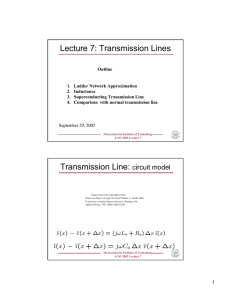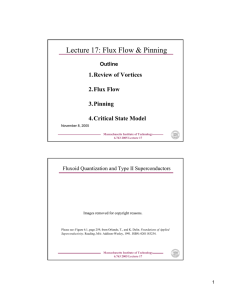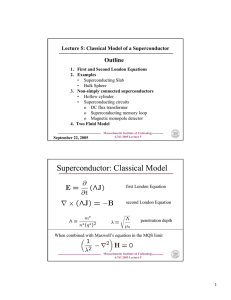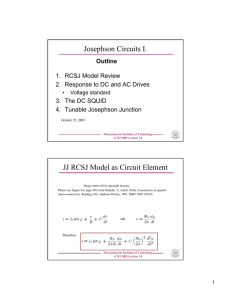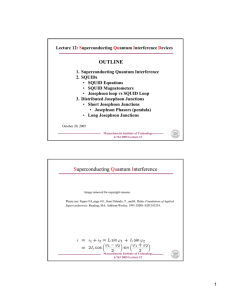Lecture 8: Perfect Diamagnetism
advertisement
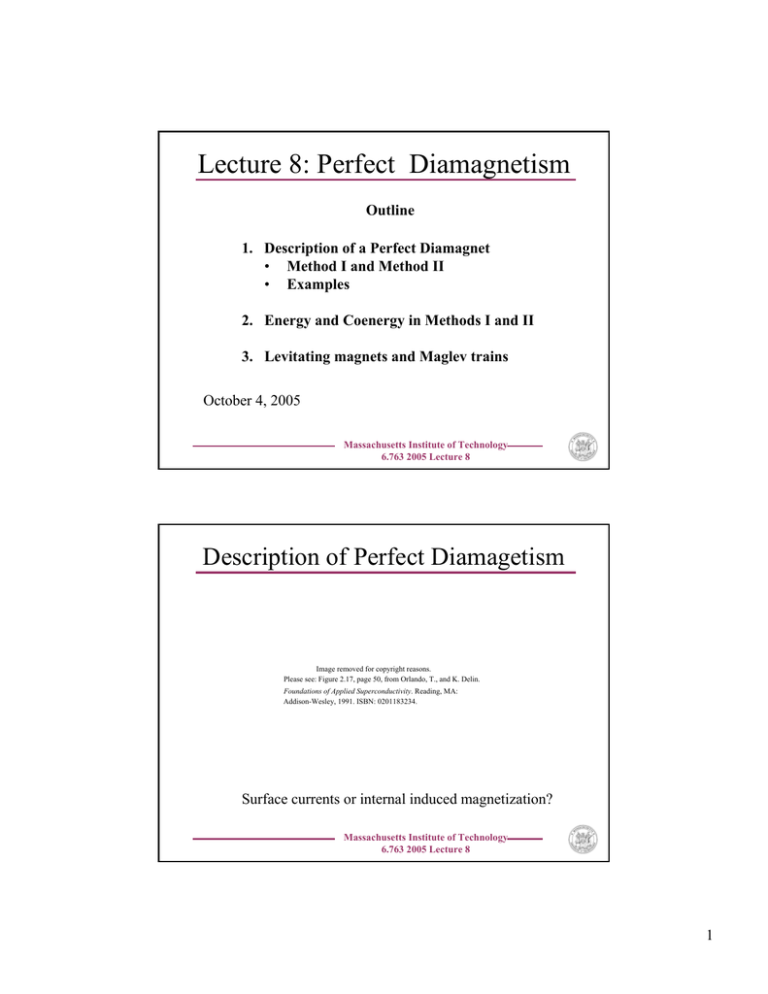
Lecture 8: Perfect Diamagnetism Outline 1. Description of a Perfect Diamagnet • Method I and Method II • Examples 2. Energy and Coenergy in Methods I and II 3. Levitating magnets and Maglev trains October 4, 2005 Massachusetts Institute of Technology 6.763 2005 Lecture 8 Description of Perfect Diamagetism Image removed for copyright reasons. Please see: Figure 2.17, page 50, from Orlando, T., and K. Delin. Foundations of Applied Superconductivity. Reading, MA: Addison-Wesley, 1991. ISBN: 0201183234. Surface currents or internal induced magnetization? Massachusetts Institute of Technology 6.763 2005 Lecture 8 1 Methods I and II Image removed for copyright reasons. Please see: Figure 4.10, page 173, from Orlando, T., and K. Delin. Foundations of Applied Superconductivity. Reading, MA: Addison-Wesley, 1991. ISBN: 0201183234. Method I Method II B field is the same in both methods. Massachusetts Institute of Technology 6.763 2005 Lecture 8 Example: Magnetized Sphere Image removed for copyright reasons. Please see: Figure 4.11, page 174, from Orlando, T., and K. Delin. Foundations of Applied Superconductivity. Reading, MA: Addison-Wesley, 1991. ISBN: 0201183234. For this example: Laplace’s equation Massachusetts Institute of Technology 6.763 2005 Lecture 8 2 Boundary Conditions Inside the sphere: Outside the sphere: Boundary Conditions: Therefore, Massachusetts Institute of Technology 6.763 2005 Lecture 8 Magnetized Sphere Image removed for copyright reasons. Please see: Figure 4.11, page 174, from Orlando, T., and K. Delin. Foundations of Applied Superconductivity. Reading, MA: Addison-Wesley, 1991. ISBN: 0201183234. Massachusetts Institute of Technology 6.763 2005 Lecture 8 3 Magnetized Sphere in field Image removed for copyright reasons. Please see: Figure 4.11, page 174, from Orlando, T., and K. Delin Foundations of Applied Superconductivity. Reading, MA: Addison-Wesley, 1991. ISBN: 0201183234. For this to describe a superconductor (bulk limit), then B=0 inside. Therefore, So that Massachusetts Institute of Technology 6.763 2005 Lecture 8 Comparison of Methods Method I Method II Inside a bulk superconducting sphere: B field is the same, but not H. Massachusetts Institute of Technology 6.763 2005 Lecture 8 4 Methods I and II: Summary Maxwell’s Equations Method I Method II London Equations Massachusetts Institute of Technology 6.763 2005 Lecture 8 Why Method II Question: The constitutive relations and London’s Equations have gotten much more difficult. So why do Method II? Answer: The Energy and Thermodynamics are easier, especially when there is no applied current. So we will find the energy stored in both methods. Poynting’s theorem is a result of Maxwell’s equation, so both methods give Massachusetts Institute of Technology 6.763 2005 Lecture 8 5 Method I: The Energy Combining the constitutive relations with Poynting’s theorem, Power dW/dt in the E&M field The energy stored in the electromagnetic field is So that the energy W is a function of D, B, and ΛJsI= vs . However, one rarely has control over these variables, but rather over their conjugates E, HI, and JsI. Massachusetts Institute of Technology 6.763 2005 Lecture 8 Method I: The Coenergy The coenergy is a function of E, HI, and JsI is defined by and with gives EQS MQS (The coenergy is the Free Energy at zero temperature.) Massachusetts Institute of Technology 6.763 2005 Lecture 8 6 Interpretation of the Coenergy Consider the case where there are only magnetic fields: Image removed for copyright reasons. Please see: Figure 4.12, page 184, from Orlando, T., and K. Delin. Foundations of Applied Superconductivity. Reading, MA: Addison-Wesley, 1991. ISBN: 0201183234. The energy and coenergy contain the same information. Massachusetts Institute of Technology 6.763 2005 Lecture 8 Method II In the important case when of the MQS limit and Note that these two relations apply also in free space. Massachusetts Institute of Technology 6.763 2005 Lecture 8 7 Example: Energy of a Superconducting Sphere Image removed for copyright reasons. Please see: Figure 2.18, page 50, from Orlando, T., and K. Delin. Foundations of Applied Superconductivity. Reading, MA: Addison-Wesley, 1991. ISBN: 0201183234. Massachusetts Institute of Technology 6.763 2005 Lecture 8 Magnetic Levitation Image removed for copyright reasons. Please see: Figure 4.17, page 195, from Orlando, T., and K. Delin. Foundations of Applied Superconductivity. Reading, MA: Addison-Wesley, 1991. ISBN: 0201183234. Image removed for copyright reasons. Please see: Figure 4.18, page 195, from Orlando, T., and K. Delin. Foundations of Applied Superconductivity. Reading, MA: Addison-Wesley, 1991. ISBN: 0201183234. Massachusetts Institute of Technology 6.763 2005 Lecture 8 8 Magnetic vs. Gravitational Forces Image removed for copyright reasons. Please see: Figure 4.17, page 195, from Orlando, T., and K. Delin. Foundations of Applied Superconductivity. Reading, MA: Addison-Wesley, 1991. ISBN: 0201183234. Image removed for copyright reasons. Please see: Figure 4.19, page 196, from Orlando, T., and K. Delin. Foundations of Applied Superconductivity. Reading, MA: Addison-Wesley, 1991. ISBN: 0201183234. Massachusetts Institute of Technology 6.763 2005 Lecture 8 Magnetic Levitation Equilibrium Point Image removed for copyright reasons. Please see: Figure 4.20, page 198, from Orlando, T., and K. Delin. Image removed for copyright reasons. Please see: Figure 4.21, page 199, from Orlando, T., and K. Delin. Foundations of Applied Superconductivity. Reading, MA: Addison-Wesley, 1991. ISBN: 0201183234. Foundations of Applied Superconductivity. Reading, MA: Addison-Wesley, 1991. ISBN: 0201183234. Force is upwards Equilibrium point Massachusetts Institute of Technology 6.763 2005 Lecture 8 9 Levitating magnets and trains Image removed for copyright reasons. Please see: Figure 4.17, page 195, from Orlando, T., and K. Delin. Foundations of Applied Superconductivity. Reading, MA: Addison-Wesley, 1991. ISBN: 0201183234. B = 1 Tesla Area = 0.5 cm2 η0 = 1 cm Force = 1 Newton Image removed for copyright reasons. Please see: Figure 4.22, page 202, from Orlando, T., and K. Delin. Foundations of Applied Superconductivity. Reading, MA: Addison-Wesley, 1991. ISBN: 0201183234. B = 2 Tesla Area = 100 cm2 η0 = 10 cm Force = 1,200 Newtons Enough to lift magnet, but not a train Enough to lift a train Massachusetts Institute of Technology 6.763 2005 Lecture 8 Maglev Train Image removed for copyright reasons. Please see: Figure 4.22, page 202, from Orlando, T., and K. Delin. Foundations of Applied Superconductivity. Reading, MA: Addison-Wesley, 1991. ISBN: 0201183234. Magnets on the train are superconducting magnets; the rails are ohmic! Massachusetts Institute of Technology 6.763 2005 Lecture 8 10 Principle of Maglev The train travels at a velocity U, and the moving flux lines and the rails “see” a moving magnetic field at a frequency of ω ~ U/R. If this frequency is much larger than the inverse of the magnetic diffusion time, then the flux lines are “repelled” from the ohmic rails. From the previous numbers, U > 40 km/hr for levitation. Massachusetts Institute of Technology 6.763 2005 Lecture 8 Real trains have wheels and high-voltage rails Image removed for copyright reasons. Please see: Figure 4.23, page 203, from Orlando, T., and K. Delin. Foundations of Applied Superconductivity. Reading, MA: Addison-Wesley, 1991. ISBN: 0201183234. Synchronous motor action down the rails provides thrust to accelerate train to the needed velocity to levitate, and provides a source of energy to further accelerate the train and to overcome the losses due to drag from the wind. Massachusetts Institute of Technology 6.763 2005 Lecture 8 11 Macroscopic Quantum Model Our Approach to Superconductivity Cl cal i s as Superconductor as a perfect conductor & perfect diamagnet Macroscopic Quantum Model Ψ(r) Supercurrent Equation Js(r) Type II Superconductivity Josephson Equations Large-Scale Applications Small-Scale Applications Ginzburg-Landau Ψ(r) = | Ψ(r)|2 e iθ(r,t) Microscopic Quantum BCS Massachusetts Institute of Technology 6.763 2005 Lecture 8 12
